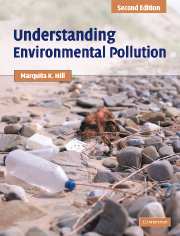Book contents
- Frontmatter
- Contents
- Preface
- Acknowledgements
- List of abbreviations and acronyms
- Chapter 1 Understanding pollution
- Chapter 2 Reducing pollution
- Chapter 3 Chemical toxicity
- Chapter 4 Chemical exposures and risk assessment
- Chapter 5 Air pollution
- Chapter 6 Acidic deposition
- Chapter 7 Global climate change
- Chapter 8 Stratospheric-ozone depletion
- Chapter 9 Water pollution
- Chapter 10 Drinking-water pollution
- Chapter 11 Solid waste
- Chapter 12 Hazardous waste
- Chapter 13 Energy
- Chapter 14 Persistent, bioaccumulative, and toxic
- Chapter 15 Metals
- Chapter 16 Pesticides
- Chapter 17 Pollution at home
- Chapter 18 Zero waste, zero emissions
- Index
Preface
- Frontmatter
- Contents
- Preface
- Acknowledgements
- List of abbreviations and acronyms
- Chapter 1 Understanding pollution
- Chapter 2 Reducing pollution
- Chapter 3 Chemical toxicity
- Chapter 4 Chemical exposures and risk assessment
- Chapter 5 Air pollution
- Chapter 6 Acidic deposition
- Chapter 7 Global climate change
- Chapter 8 Stratospheric-ozone depletion
- Chapter 9 Water pollution
- Chapter 10 Drinking-water pollution
- Chapter 11 Solid waste
- Chapter 12 Hazardous waste
- Chapter 13 Energy
- Chapter 14 Persistent, bioaccumulative, and toxic
- Chapter 15 Metals
- Chapter 16 Pesticides
- Chapter 17 Pollution at home
- Chapter 18 Zero waste, zero emissions
- Index
Summary
Understanding Environmental Pollution has been updated and almost completely revised. The book summarizes the basics of pollution, working to use language understandable to those with limited science background, while remaining useful to those with more. The impacts of pollution on environmental health receive greater attention in this edition, and there are more case descriptions, which pose reflective questions to the reader. The second edition also has greater emphasis on pollution problems in less-developed nations. It often delves too into pollution that moves beyond national boundaries. In addition, more references are included at the end of chapters, including many web sites.
A framework: Chapters 1 through 4 provide basic information on pollution, the issues that it poses, and on reducing pollution. They also discuss concepts important to later chapters. Chapter 1 introduces basic concepts in pollution, and addresses how humans are affecting the environment's ability to provide “natural services.” Chapter 2 describes “comparative risk assessment,” and overviews how society deals with risks. The waste-management hierarchy with its stress on pollution prevention is introduced here too, as is industrial symbiosis, treating wastes as resources. Chapter 3 introduces toxicity and factors affecting whether a chemical will have adverse effects. Chapter 4 emphasizes that exposure must occur before a chemical poses a risk, and describes how chemical risk is evaluated.
Pollution basics: Chapter 5 delves into the major pollutants in ambient air, the concerns that they pose, their sources, and efforts to reduce their emissions.
- Type
- Chapter
- Information
- Understanding Environmental PollutionA Primer, pp. ix - xPublisher: Cambridge University PressPrint publication year: 2004

